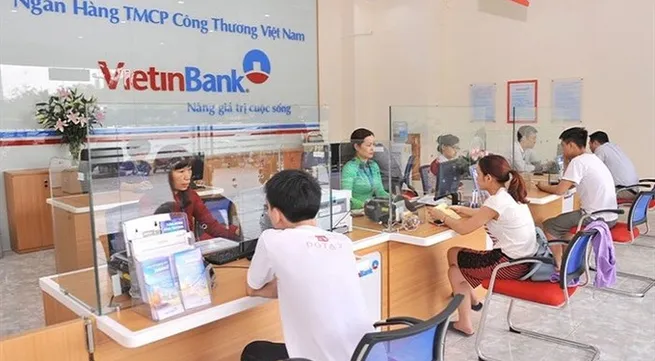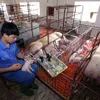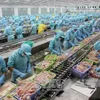State-owned banks suffer equity erosion
by ,http://vietnamnews.vn/economy/business-beat/464116/state-owned-banks-suffer-equity-erosion.html20 August 2018 Last updated at 08:59 AM


|
| Việt Nam has seven State-owned banks, the biggest of which are Vietcombank, Vietinbank, Agribank and BIDV. — Photo Vietnam Finance |
Compiled by Thiên Lý
According to statistics from the State Bank of Việt Nam (SBV), as of May, State-owned banks’ combined equity was VNĐ252.472 trillion (US$10.83 billion), down 0.86 per cent.
Other lenders’ equity was VNĐ315.340 trillion ($13.5 billion) after rising by 8.5 per cent.
Việt Nam has seven State-owned banks, the biggest of which are Vietcombank, Vietinbank, Agribank and BIDV.
Analysts attributed the State-owned banks’ negative equity growth to the fact they had to support three banks that the central bank had to buy out: Construction Bank, GPBank and Oceanbank.
In 2015, the SBV bought the banks and this year assigned the four biggest State-owned banks to restructure them to improve their liquidity and management.
A senior banking expert pointed out another reason that had caused the State-owned banks to achieve negative capital growth.
He said some banks including State-owned ones had to issued debt instruments like bonds and certificates of deposit to increase their tier II capital in recent years.
But Circular 36 requires that every year the issuers should amortise their bonds, resulting in negative capital growth. Thus, every year their capital will come down by 20 per cent of the value of their tier II capital if the bonds are for long term.
In this situation, issuing equity to local and foreign investors is considered by many analysts as the most effective way for State-owned banks to increase their capital.
However, some analysts pointed out not many local investors have resources to immediately invest trillions of đồng.
So the only way is to seek foreign investment instead, they said.
That begs the question, “Is it easy to attract foreign investment?”
State-owned lenders’ capital adequacy ratio (CAR) is only 9.39 per cent, which puts them in a risky situation when based on Basel norms, while private banks have a CAR of 11.34 per cent.
Analysts said the former need to quickly find a way to strengthen their capital because under Basel II norms, risky loans would reduce their equity further.
This would have an impact on the entire banking sector, analysts said.
Vietcombank, Vietinbank, Agribank and BIDV account for about half of the total assets and 40 per cent of all deposits and loans in the banking system.
This means if their capital is not increased, the whole system would be at risk, the analysts said.
Without increasing their capital, soon they would simply not be able to lend more, meaning they would fail in their task of keeping the economy’s financial wheels greased.
To avoid these risks, the Government should quickly divest from State-owned banks and instead allow private capital to replace it, the analysts said.
Runaway dollar: How can companies cope with exchange rate risks?
On August 14, Vietcombank decided to set its dollar buying rate at VNĐ23,287 and selling rate at VNĐ23,367 per dollar, reducing the Việt Nam đồng’s value by 17 đồng.
They represent the highest ever rates set by the bank for the greenback.
Techcombank too set record rates that day, buying and selling at VNĐ23,250 and VNĐ23,367, respectively.
Explaining the sudden fall in the đồng’s value against the dollar, analysts said the relentless rise in the US Federal Reserve’s dollar base rate under a roadmap and the sharp rise in interest rates on US bonds made the greenback stronger.
Recent global political and economic events, particularly the US-China trade war, have also caused pressure on Việt Nam’s foreign exchange rates.
The question many people are asking is what are companies doing to hedge against the exchange rate volatility which is expected to continue for some time.
The Minh Phú Seafood Corporation is one of many companies vulnerable to fluctuations in the dollar-đồng exchange rate.
It breeds, processes, preserves and trades aquatic products in Việt Nam and internationally; processes and trades fish powder and bio-fuel made from fish oil; trades goods, materials, machinery, and equipment for aquaculture; and invests and trades in infrastructure.
The company has to import a majority of its inputs like shrimp feed, packaging and processing additives.
So it has been badly affected by the exchange rate volatility.
A company executive said though its costs have increased sharply as a result of the Vietnamese currency’s weakening against the dollar, it cannot increase prices if it wants to remain competitive in the global market.
Since the second quarter, some other major shrimp exporters like Indonesia and India have been having a good time because of a bumper crop and sharp depreciation of their currency, he said.
Minh Phú is under great pressure as it seeks to keep its prices unchanged while also improving quality to survive, he said.
He admitted that the company’s profit margins have dropped somewhat.
What about the fate of enterprises which have large foreign currency debts?
Among them is PetroVietnam Power Corporation (PV Power).
The company needs large sums of foreign currency to pay back the debts that it has already run up during the construction of its power plant.
Its debt-to-equity ratio now is 44 per cent.
The company’s difficulty is that its revenues, which come mainly from selling electricity, are in đồng.
This results in an obvious disadvantage when the Vietnamese currency loses ground against the greenback.
In the second half of this yea,r the company is expected to achieve VNĐ800 billion ($34.3 million) in profit after paying tax if the đồng depreciates by 2 per cent by year-end.
Industry insiders said every 1 per cent depreciation in the đồng would see PV Power’s profit decrease by about VNĐ88.4 billion.
The management of the PetroVietnam Cà Mau Fertiliser Joint Stock Company, which also has foreign currency debts, said the company would repay the debts before schedule.
This decision has helped it to significantly reduce the additional costs arising from the weakening of the đồng, it said.
Analysts said that global trade tensions, the high risks in a monetary war, the trade protectionism trend, and policy instability in many countries around the world are the main factors that raise the spectre of currency devaluation for developing countries like Việt Nam.
They said the currencies of Argentina, Turkey, India and China have plunged in recent times by between 10 and even 30 per cent.
Việt Nam’s đồng is likely to fall by 2 to 3 per cent this year, experts said.
Enterprises need to make careful plans to cope with exchange rate fluctuations and the possible changes in the local and global monetary markets to hedge their risks, they said. — VNS





